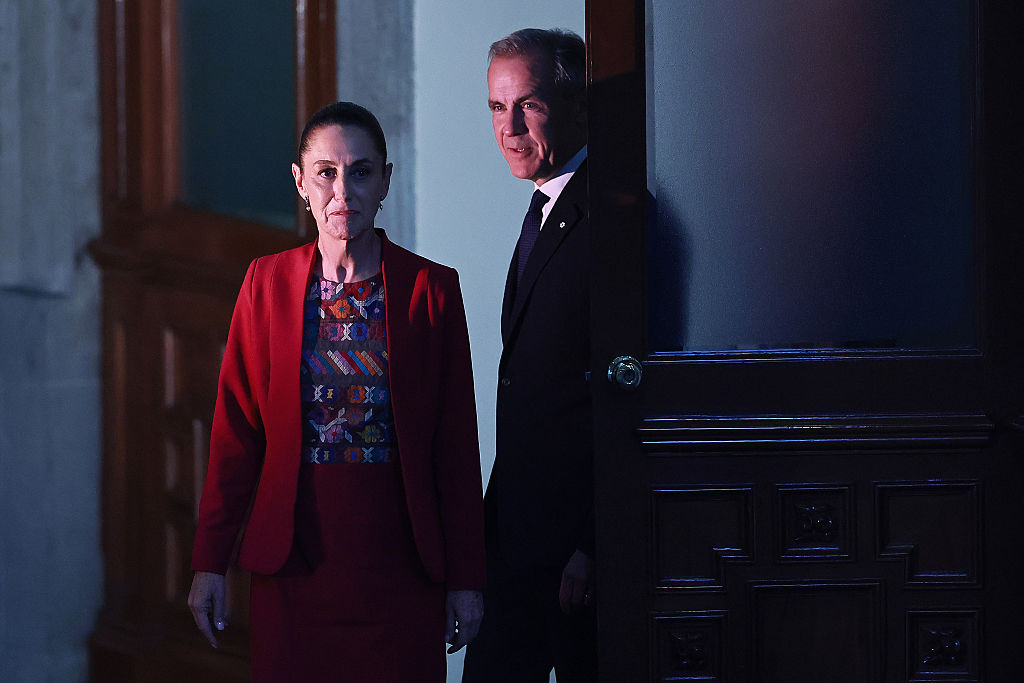Canada and Mexico Begin Shoring Up Shaky USMCA
The free-trade deal, which replaced NAFTA, is up for renegotiation in 2026.

Canada’s Prime Minister Mark Carney dropped down to Mexico Thursday to meet with that country’s President Claudia Sheinbaum and form a united front, as the two major trade partners prepare for the renegotiation of the U.S.–Mexico–Canada Agreement (USMCA) on free trade in the summer of 2026. Both countries have been the subject of numerous tariff threats from President Donald Trump, whose protectionist policies have menaced America’s neighbors and undermined the integrity of the North American free-trade bloc.
Justifying the continued economic integration of the region emerged as a key theme of the conference. “USMCA is a testament to [how], if Mexico, Canada, and the United States work together, we can create prosperity, face global challenges successfully and position ourselves as the most dynamic region in the world,” Sheinbaum told reporters during the subsequent press conference.
Sheinbaum has made preserving free trade with the U.S. a priority, and she has gone to significant lengths to improve the attractiveness of Mexican markets to Trump. Earlier this month, Sheinbaum announced that Mexico would be imposing tariffs of up to 50 percent on Chinese imports, a measure aimed as much at disarming American accusations that Mexico serves as a “dumping ground” where under-market Chinese imports are resold to circumvent American import duties as it is at reducing Mexican dependence on Chinese industry. “We want to maintain the USMCA,” the Mexican president declared Wednesday.
Both Mexico and Canada are heavily dependent on trade with the U.S.: More than three-fourths of both countries’ exports were America-bound in 2024. This has proven a source of political and economic stress since the beginning of the second Trump administration, as the 47th president has attempted to wield America’s massive import market as a geopolitical weapon to extract concessions from neighbors and far-flung trade partners alike.
Tariff spats with Canada were especially sharp, as Ottawa’s determination to retaliate with countertariffs led to an escalating growth of trade barriers until an August climb-down by Carney. Mexico, on the other hand, escaped with limited tariffs on steel and automotive manufacturing. Sheinbaum steadfastly refused provocative or confrontational responses and instead cooperated extensively with requests from the White House, a strategy which appears to have served her administration well.
American irascibility appears to have created a consensus that the two countries need to cooperate to preserve the economic infrastructure of North American free trade. “North America is the economic envy of the world, is the most competitive economic region of the world, and part of the reason for that is the cooperation between Canada and Mexico,” Carney said after arriving in Mexico City. The cooperative approach is a contrast to the original negotiations for the USMCA in 2018, when Mexico conducted a set of unilateral negotiations with the U.S. about the resolution of commercial disputes and other important details of the agreement—an act Canadian commentators later characterized as Mexico throwing Canada under the bus.
In addition to collaborating on free trade negotiations for 2026, Sheinbaum and Carney also inaugurated an important new partnership, the Canada–Mexico Action Plan 2025-2028, which aims to increase trade between the two countries and pledges increased integration between and investment in railway, port, and airport infrastructure. The Action Plan also includes cooperation on security matters—a subject which has been a major point of friction with the U.S. for both countries, as Trump seeks to reduce illegal drugs entering the country across either border. Sheinbaum seemed particularly pleased with having secured assistance with cybersecurity matters from Canada, a capacity which slots neatly into her national program for a vigorous and proactive national intelligence service capable of infiltrating and disrupting cartel operations in the country.
While Donald Trump’s name was undoubtedly on the minds of everyone at the summit, both leaders carefully avoided making provocative or hostile statements about the U.S. and its president. The partners remained relentlessly focused on making the positive case for North American cooperation and economic integration—a proposition that has become much more controversial in the U.S. than it was during the inauguration of the North American Free Trade Agreement in 1992.
As the 2026 USMCA renegotiation looms, the meeting between Carney and Sheinbaum marks an interesting strategic development in North American diplomacy. Canada is abandoning its hostile attitude and defensive approach towards assertive U.S. trade policy, an admission that Sheinbaum’s quiet cooperation proved the superior tactic. Instead, the countries are seeking to combine their influence—both diplomatic and economic—to counter the overwhelming heft of the American consumer market. That approach may prove important, as the second Trump administration has demonstrated a much more active interest in remaking U.S. trade relations with other countries than the first—a development which is likely to dominate the 2026 trade talks.
The post Canada and Mexico Begin Shoring Up Shaky USMCA appeared first on The American Conservative.

